
Mil Máscaras is a Mexican luchador and actor. He is regarded as one of the greatest wrestlers of the lucha libre tradition in Mexico – along with El Santo and Blue Demon – and has been described as the first international superstar of lucha libre. Mil Máscaras is considered one of the most influential wrestlers of all time for enhancing and popularizing the lucha libre style around the world, both in the ring and as the star of 20 films. He is also an accomplished artist and cultural ambassador for his native country and has appeared on three of its postage stamps. Although he has never been unmasked and his true identity is generally kept a secret out of respect for lucha libre traditions, his real name is known due to appearing in the credits of the films he has starred in. His ring name is Spanish for "Thousand Masks".
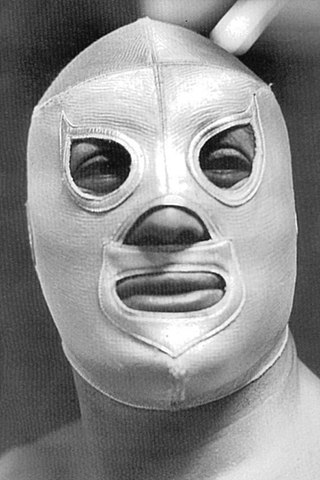
Rodolfo Guzmán Huerta, best known by his ring name El Santo, was a Mexican luchador enmascarado, actor and folk hero. He is one of the most famous and iconic Mexican luchadores, and has been referred to as one of "the greatest legends in Mexican sports". His wrestling career spanned nearly five decades, during which he became a folk hero and a symbol of justice for the common man through his appearances in luchador films and comic books telling fictionalized stories of El Santo fighting for justice. He starred or co-starred in at least 54 movies between 1958 and 1982.

Lucha libre is the term for the style of professional wrestling originating in Mexico. Since its introduction to Mexico in the early 20th century, it has developed into a unique form of the genre, characterized by colorful masks, rapid sequences of holds and maneuvers, and "high-flying" maneuvers, some of which have been adopted in the United States, Japan, and elsewhere. The wearing of masks has developed special significance, and matches are sometimes contested in which the loser must permanently remove his mask, which is a wager with a high degree of weight attached. Tag team wrestling is especially prevalent in lucha libre, particularly matches with three-member teams, called trios.

Jorge Ernesto Guzmán Rodríguez, best known under his ring name, El Hijo del Santo, is a Mexican luchador enmascarado and political activist. He is the youngest child, out of eleven, of El Santo. Guzmán has also followed in his father's footsteps, as he has starred in several luchador films.
Huracán Ramírez is a fictitious character, originally invented for the 1953 Mexican luchador film of the same name. After the movie opened in theaters, Huracán Ramírez also became a professional wrestling character in the ring, primarily played by luchador Eduardo Bonada, who was soon after replaced in the mid-1950s by wrestler Daniel García who wrestled under that name for more than thirty years. The rights to the name and image of Huracán Ramírez were never owned by García, which has led to a number of other wrestlers using the name "Huracán Ramírez" after García retired in 1988, or variations on the theme such as Huracán Ramírez II, Huracán Ramírez Jr., El Hijo de Huracán Ramírez and so on, but all of whom had no actual family relationship to Daniel García.

Alejandro Muñoz Moreno, better known by the ring name Blue Demon, was a Mexican film actor and luchador enmascarado. Blue Demon is considered a legend of lucha libre, partially from starring in a series of Lucha films between 1961 and 1979, often alongside in-ring rival El Santo. His in-ring career began in 1948 and stretched for 41 years until his retirement in 1989.

José Luis Rodríguez Arellano is a Mexican Luchador Enmascarado who wrestles under the ring name Dos Caras. His most active years were in the 1970s and 1980s, and he achieved his greatest success in Mexico's Universal Wrestling Alliance (UWA), where he won the UWA World Heavyweight Championship three times. He has been called "the greatest heavyweight ever to come out of Mexico". He is the creator of the Dos Caras Clutch, a hammerlock head scissors pinning combination.

Carlos Delucio Lagarde is best known as Karloff Lagarde, a Mexican Luchador, or professional wrestler, who was immensely popular during the 1960s and 1970s. Through his career had faced most of Mexico's top stars of the 1950s, 1960s and 1970s including lucha libre legends such as El Santo, El Solitario, Mil Máscaras, Black Shadow, Huracán Ramírez, Gory Guerrero, Ray Mendoza and Perro Aguayo. He was known as the "king of the Welterweight" due to him holding the Mexican National Welterweight Championship four times and the NWA World Welterweight Championship three times in his career. Lagarde teamed up with René Guajardo to form a tag team known as Los Rebeldes, considered to be one of the top five tag teams in Lucha libre history.
Máximino Linares Moreno was a Mexican luchador and lucha film star, better known under the ring name Rayo de Jalisco. He is considered to be one of the best wrestlers of his generation. Linares' son followed in his footsteps and is working under the name Rayo de Jalisco Jr., wearing the same distinctive black mask with silver lightning bolt on it when wrestling. One of Linares' grandsons is also a wrestler, known as "Rayman".

Manuel Leal, better known as Tinieblas ("Darkness"), is a Mexican luchador.

Blue Demon Jr. is a Mexican professional wrestler. He is the adopted son of the original Blue Demon and is the first Mexican and second masked wrestler to win the NWA World Heavyweight Championship thus making him a one-time world champion. His real name is unknown to the public, as is often the case with masked wrestlers in Mexico, where their private lives are kept secret from fans.

Mil Mascaras vs. the Aztec Mummy is a 2007 Mexican-American lucha libre film starring the legendary Mexican wrestler and cult film star Mil Máscaras. It has the distinction of being the first lucha film starring any of the "Big 3" to be produced in English. It was a tribute to the 1960s Mexican horror and lucha libre films and was the first of a trilogy of Mil Mascaras films that includes Academy of Doom (2008) and Aztec Revenge (2015).

Huracán Ramírez is a 1953 black-and-white Mexican luchador film directed by Joselito Rodríguez and co-written by Joselito Rodríguez, Juan Rodríguez Mas, and Jesús Saucedo. The film follows the story of Fernando Torres, a young man who decides to follow in his father's footsteps by donning the secret identity of Huracán Ramírez, a masked luchador, despite his father's wishes to the contrary.
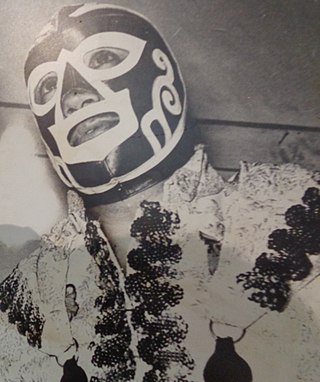
Daniel García Arteaga, best known under the ring name Huracán Ramírez, was a Mexican luchador enmascarado and actor. García was neither the first, nor the last, wrestler to work under the name "Huracán Ramírez". He was given the name in the mid-1950s, when the wrestler who originally played Huracán in the 1953 film Huracán Ramírez decided to give up the role in the ring because he no longer wanted to obscure his face with the mask. Thus, García became the second wrestler to wrestle in the ring under the Huracán identity.

Francisco Segura García was a Mexican Boxer, Movie actor and Luchador, or professional wrestler best known under the ring name Firpo Segura, given the name after the Argentine boxer Luis Ángel Firpo. As a boxer he held both the Mexican Light Heavyweight and Heavyweight Championship and as a luchador he won the Mexican National Heavyweight Championship on four occasions and the Mexican National Middleweight Championship once. Segura became one of the first Mexican born stars of Lucha Libre and is at times referred to as the "First Idol of Lucha Libre" being one of the first Mexican born wrestlers to receive top billing in lucha libre.

Los Espantos, sometimes referred to as Los Hermanos Espanto, was a Mexican professional wrestling group, called a stable. The original Espantos team consisted of Espanto I and Espanto II, but later expanded to a trio when Espanto III, the younger brother of Espanto I, joined the group. They primarily worked as a rudo faction for Empresa Mexicana de Lucha Libre (EMLL) and on the Mexican independent circuit. As a team Espanto I and II held the Mexican National Tag Team Championship and Espanto II and III held the Northern Mexico Tag Team Championship. The team of Espanto I and Espanto II are considered among the best rudo teams in the history of lucha libre.
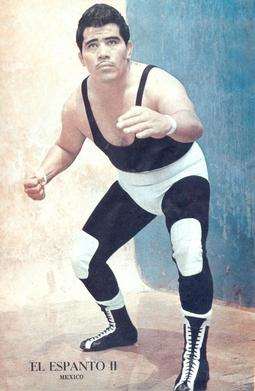
Fernando Cisneros Carrillo, was a Mexican luchador or professional wrestler known under the ring name Espanto II. For most of his career he was closely associated with his tag team partner and close friend José Vázquez, better known as Espanto I as well as Miguel Vázquez known as Espanto III, with the three collectively known as Los Espantos
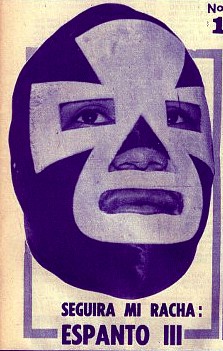
Miguel "Miguelito" Vázquez Bernal, was a Mexican luchador or professional wrestler known under the ring name Espanto III. During his career in lucha libre he formed a long running, successful trio known as Los Espantos with his brother José Eusebio Vázquez Bernal and Fernando Cisneros Carrillo.
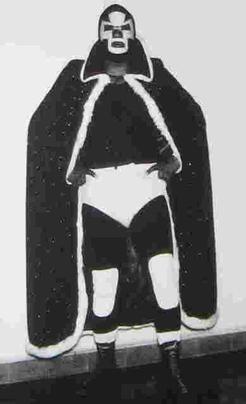
José Eusebio Vázquez Bernal, was a Mexican luchador, or professional wrestler from the mid-1950s until his death in 1968, best known under the ring name Espanto I, part of Los Espantos alongside his lifelong friend Fernando Cisneros Carrillo and his younger brother Miguel Vázquez Bernal. As Los Espantos the three became one of the first "Identical teams" in Mexico.

El Santo was a luchador enmascarado who portrayed a fictionalized version of himself in numerous luchador films from 1961 to 1982.


















